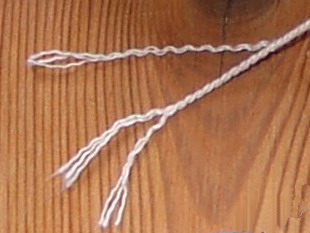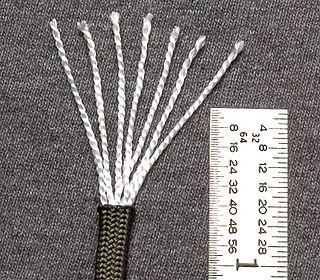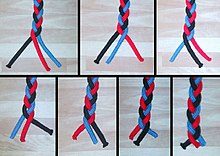
Knitting is a method for production of textile fabrics by interlacing yarn loops with loops of the same or other yarns. It is used to create many types of garments. Knitting may be done by hand or by machine.

Yarn is a long continuous length of interlocked fibres, used in sewing, crocheting, knitting, weaving, embroidery, ropemaking, and the production of textiles. Thread is a type of yarn intended for sewing by hand or machine. Modern manufactured sewing threads may be finished with wax or other lubricants to withstand the stresses involved in sewing. Embroidery threads are yarns specifically designed for needlework. Yarn can be made of a number of natural or synthetic materials, and comes in a variety of colors and thicknesses. Although yarn may be dyed different colours, most yarns are solid coloured with a uniform hue.

Textile arts are arts and crafts that use plant, animal, or synthetic fibers to construct practical or decorative objects.

A rope is a group of yarns, plies, fibres, or strands that are twisted or braided together into a larger and stronger form. Ropes have tensile strength and so can be used for dragging and lifting. Rope is thicker and stronger than similarly constructed cord, string, and twine.
Whipcord is the name for either a fabric or a form of braided cord.

A French braid, also called a French plait, is a type of braided hairstyle. The three-strand gathered plait includes three sections of hair that are braided together from the crown of the head to the nape of the neck.

Metallic fibers are manufactured fibers composed of metal, metallic alloys, plastic-coated metal, metal-coated plastic, or a core completely covered by metal.

Twine is a strong thread, light string or cord composed of string two or more thinner strands twisted, and then twisted together (plied). The strands are plied in the opposite direction to that of their twist, which adds torsional strength to the cord and keeps it from unravelling. This process is sometimes called reverse wrap. The same technique used for making twine is also used to make thread, which is thinner, yarn, and rope, which is stronger and thicker, generally with three or more strands.

Parachute cord is a lightweight nylon kernmantle rope originally used in the suspension lines of parachutes. This cord is now used as a general purpose utility cord. This versatile cord was used by astronauts during the 82nd Space Shuttle mission to repair the Hubble Space Telescope.

Bast fibre is plant fibre collected from the phloem or bast surrounding the stem of certain dicotyledonous plants. Some of the economically important bast fibres are obtained from herbs cultivated in agriculture, for instance flax, hemp, or ramie, but bast fibres from wild plants, such as stinging nettle, and trees such as lime or linden, willow, oak, wisteria, and mulberry have also been used. Bast fibres are soft and flexible, as opposed to leaf fibres from monocotyledonous plants, which are hard and stiff.

Wire rope is composed of as few as two solid, metal wires twisted into a helix that forms a composite rope, in a pattern known as laid rope. Larger diameter wire rope consists of multiple strands of such laid rope in a pattern known as cable laid. Manufactured using an industrial machine known as a strander, the wires are fed through a series of barrels and spun into their final composite orientation.

The eye splice is a method of creating a permanent loop in the end of a rope by means of rope splicing.

Cable knitting is a style of knitting in which textures of crossing layers are achieved by permuting stitches. For example, given four stitches appearing on the needle in the order ABCD, one might cross the first two the next two, so that in subsequent rows those stitches appear in the new order CDAB.
The manufacture of textiles is one of the oldest of human technologies. To make textiles, the first requirement is a source of fiber from which a yarn can be made, primarily by spinning. The yarn is processed by knitting or weaving, which turns it into cloth. The machine used for weaving is the loom. For decoration, the process of colouring yarn or the finished material is dyeing. For more information of the various steps, see textile manufacturing.

Novelty yarns include a wide variety of yarns made with unusual features, structure or fiber composition such as slubs, inclusions, metallic or synthetic fibers, laddering and varying thickness introduced during production. Some linens, wools to be woven into tweed, and the uneven filaments of some types of silk are allowed to retain their normal irregularities, producing the characteristic uneven surface of the finished fabric. Man-made fibres, which can be modified during production, are especially adaptable for special effects such as crimping and texturizing.

A braiding machine is a device that interlaces three or more strands of yarn or wire to create a variety of materials, including rope, reinforced hose, covered power cords, and some types of lace. Braiding materials include natural and synthetic yarns, metal wires, leather tapes, and others.

Synthetic dreads, also called dread extensions, dread falls, and cyberlocks, are interlocked coils of synthetic hair, mostly kanekalon, that give the look and feel of natural dreadlocks without the commitment or maintenance. They are mainly worn as a fashion statement for the subculture of cybergoth.

String is a long flexible structure made from fibers twisted together into a single strand, or from multiple such strands which are in turn twisted together. String is used to tie, bind, or hang other objects. It is also used as a material to make things, such as textiles, and in arts and crafts. String is a simple tool, and its use by humans is known to have been developed tens of thousands of years ago. In Mesoamerica, for example, string was invented some 20,000 to 30,000 years ago, and was made by twisting plant fibers together. String may also be a component in other tools, and in devices as diverse as weapons, musical instruments, and toys.

Box braids are a type of hair-braiding style that is predominantly popular among African people and the African diaspora. This type of hairstyle is a "protective style" and is "boxy", consisting of square-shaped hair divisions. Box braids are generally installed by using synthetic hair which helps to add thickness as well as helping the natural hair that is in the braid. Because they are not attached to the scalp like other similar styles such as cornrows, box braids can be styled in a number of different ways. The installation process of box braids can be lengthy, but once installed they can last for six to eight weeks. They are known for being easy to maintain.

Braids are a complex hairstyle formed by interlacing three or more strands of hair. Braiding has been used to style and ornament human and animal hair for thousands of years in various cultures around the world.
























